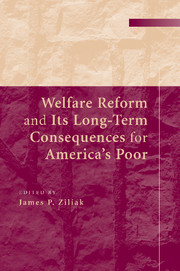Book contents
- Frontmatter
- Contents
- Contributors
- Preface
- Introduction
- 1 What We Know, What We Don't Know, and What We Need to Know about Welfare Reform
- 2 Welfare Reform and the Level and Composition of Income
- 3 How Have Expansions in the Earned Income Tax Credit Affected Family Expenditures?
- 4 How Families Are Doing Nine Years after Welfare Reform: 2005 Evidence from the Three-City Study
- 5 The Impact of Welfare Reform on Leaver Characteristics, Employment, and Recidivism
- 6 A Reexamination of the Impact of Welfare Reform on Health Insurance Among Less-Skilled Women
- 7 How Welfare Policies Affect Child and Adolescent School Performance: Investigating Pathways of Influence with Experimental Data
- 8 The Effects of Welfare and Child Support Policies on the Incidence of Marriage Following a Nonmarital Birth
- 9 Welfare Reform and Health among the Children of Immigrants
- 10 Mismatches and Unmet Need: Access to Social Services in Urban and Rural America
- Index
2 - Welfare Reform and the Level and Composition of Income
Published online by Cambridge University Press: 21 January 2010
- Frontmatter
- Contents
- Contributors
- Preface
- Introduction
- 1 What We Know, What We Don't Know, and What We Need to Know about Welfare Reform
- 2 Welfare Reform and the Level and Composition of Income
- 3 How Have Expansions in the Earned Income Tax Credit Affected Family Expenditures?
- 4 How Families Are Doing Nine Years after Welfare Reform: 2005 Evidence from the Three-City Study
- 5 The Impact of Welfare Reform on Leaver Characteristics, Employment, and Recidivism
- 6 A Reexamination of the Impact of Welfare Reform on Health Insurance Among Less-Skilled Women
- 7 How Welfare Policies Affect Child and Adolescent School Performance: Investigating Pathways of Influence with Experimental Data
- 8 The Effects of Welfare and Child Support Policies on the Incidence of Marriage Following a Nonmarital Birth
- 9 Welfare Reform and Health among the Children of Immigrants
- 10 Mismatches and Unmet Need: Access to Social Services in Urban and Rural America
- Index
Summary
Introduction
The Personal Responsibility and Work Opportunity Reconciliation Act (PRWORA) of 1996 had many goals, not least of which was ending dependence on government benefits through promotion of work. The new welfare program was expected to work in conjunction with the Earned Income Tax Credit (EITC), whose expanded generosity in the early 1990s increased the incentive for low-income families to enter the labor force. A significant body of research was spawned in the wake of welfare reform and EITC expansions, but most of the analyses have relied on data and outcomes prior to 2000 (Grogger and Karoly 2005; Hotz and Scholz 2003), and research on interactions between the macroeconomy and social policy reforms on income levels, as well as on the distribution of income, is scarce (Meyer and Sullivan 2006; Mills, Alwang, and Hazarika 2001; Schoeni and Blank 2000). In this chapter we estimate how welfare reform, the macroeconomy, and the EITC affected the level and composition of income across the distribution of single-mother families.
The target of welfare reform was low-income single mothers, as this demographic group historically comprised over 90 percent of the caseload. Although the typical (noncensored) spell on Aid to Families with Dependent Children (AFDC) for single mothers was only about eight months (Blank and Ruggles 1996), the public perception of long-term dependence and intergenerational transmission was widespread and not altogether false from a lifetime perspective (Blank 1997).
- Type
- Chapter
- Information
- Publisher: Cambridge University PressPrint publication year: 2009
- 19
- Cited by



